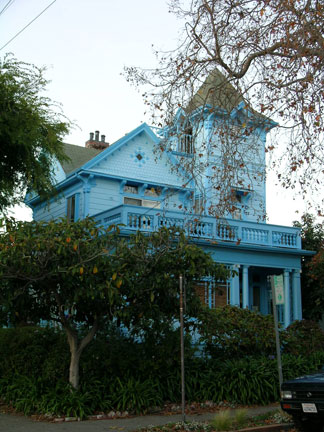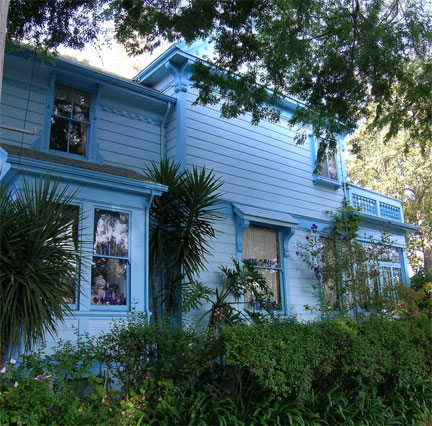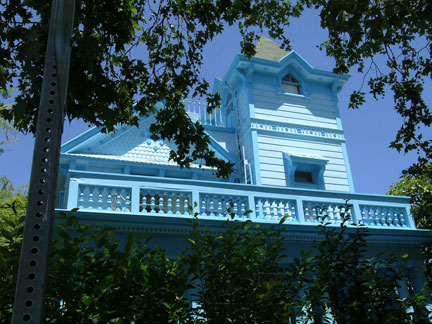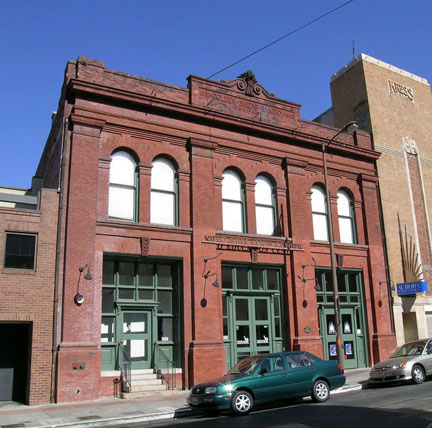The carpenter, the baker, and the Classics professor
20 July 2009
Moran-Wright house, 2001 Francisco Street (photo: Daniella Thompson, 2009)
Photo: Daniella Thompson, 2007
The sky-blue Victorian villa—part Stick-Eastlake, part Gothic Revival, and proudly holding aloft a tower and weathervane on the northeastern corner of Francisco and Milvia Streets—is a striking sight.
Passersby who know nothing of its storied past are often captivated by the rows of cobalt-blue glass bottles lined up along its window sills. If they raise their eyes, they may admire the handsomely proportioned windows, the classically balustraded balcony, and the numerous curved brackets gracing the house.
This edifice, popularly known as the Flagg House, has long been the subject of local legends, some of them propagated by local historians.
Photo: Daniella Thompson, 2009George A. Pettitt, author of Berkeley: The Town and Gown of It (1973), had this to say about the house:
It was built in 1880 for Professor Isaac Flagg of the Greek Department of the University. Twenty years later it was sold to Jonathan C. Wright, proprietor of the Golden Sheaf Bakery, who helped to provide board and lodging for students at the University in the 1870s. The designer and builder was John Paul Moran, a ship’s carpenter who took French leave from his ship in San Francisco Bay about 1870. [...] He left the mark of his trade by carving ships’ anchors in the beams, and etching them in the glass of the doors.
Jig saw–cut bargeboard and anchors in the rear (photo: Daniella Thompson, 2009)Pettitt was echoing similar lore disseminated by Robert Bernhardi in his book The Buildings of Berkeley (1971). Bernhardi added the following tidbit, published by the Oakland Tribune on 30 January 1972: “Flagg sold to Jonathan C. Wright in 1902, a man who had absolute disdain of conventional lighting. He contended that gas lamps were too ‘new fangled’ to be trusted ... and would go to a small house in the rear to read by kerosene lamp.”
Both Bernhardi and Pettitt were telling tall tales—delicious to read but remote from the prosaic truth. The house at 2001 Francisco Street could not have been built by John Moran in 1880, since Moran was still living in his native England at that time. Far from being a footloose mariner who jumped ship in San Francisco Bay about 1870, Moran (1852–1904) was a family man who raised eight children, the eldest three born in England between 1881 and 1883. He immigrated to the United States in 1883, his wife and children following the next year, as documented in U.S. census records.
Photo: Daniella Thompson, 2009Nor could the house have been built in 1880 for Isaac Flagg, who was then living in Ithaca, New York, where he served as professor of Greek at Cornell University until 1888. Flagg did not arrive in Berkeley until 1891, when he took up the post of temporary assistant in Latin at the University of California.
The Flagg family’s first Bay Area residence was at 1469 Telegraph Avenue in Oakland. It was not until 1892 that they made their appearance in the Berkeley directory, residing at 2001 Francisco Street, in the house that has come to bear their name but which they never owned.
What can the records tell us about the provenance and history of this intriguing house?
It is situated in the Janes Tract, Block C. In 1880, the entire block save two lots was owned by Clark Brook, a farmer whose own residence, assessed at $1,200, was the only house then standing on the block. In 1884, a second house appeared on Brook’s land. It was far more modest, assessed at $250. This house was occupied, and likely built, by John P. Moran, a carpenter who was first listed in the Berkeley directory in 1886, residing on the corner of Francisco and Milvia.
West fa�ade, Milvia Street (photo: Daniella Thompson, 2009)By 1889, Moran had purchased the property from Brook. That year, the assessed value of his improvements was $150. The following year, the value had jumped to $1,800, indicating that Moran had greatly expanded the house.
In all probability, Moran had intended the expansion as a speculative venture, for he soon sold the house to Jonathan G. Wright and a partner named Leverett, building himself a new home at 1710 Lincoln Street.
It’s interesting to note that Moran consistently listed himself as a carpenter, excepting a few occasions when he called himself a contractor and builder. In 1895, seeking to advertise his business, he paid for a directory listing with his name in capital letters, declaring himself to be an architect and builder. In only three instances—the 1900 census and the 1902 and 1903 city directories—did he call himself a ship joiner. Apparently, he hired himself out at the dockyard when house building opportunities were at a low ebb.
Photo: Daniella Thompson, 2009Jonathan Garrard Wright (1837–1924), the man who bought Moran’s house and who owned the famous Golden Sheaf Bakery on Shattuck Avenue, also began as a carpenter. An Englishman by birth, Wright immigrated to Canada as a teenager. In Toronto he met Hannah Sallows, whom he married in 1860. Two daughters were born to them in Toronto before the Wrights moved to Michigan in 1866. Here they brought to the world two more children, eventually migrating to California in the mid-1870s. In 1877, after three years of carpentry in Oakland, Wright established Berkeley’s first bakery on the west side of Shattuck Avenue between University Avenue and Addison Street. The establishment included a restaurant that came to be known as the Alpha Dining Rooms, and the building was named the Alpha Block.
The Golden Sheaf Bakery was located in the Alpha Block (Sanborn fire insurance map, 1894)If the Wrights took in student boarders in the 1870s as Pettitt suggests, the records say nothing about it. In the 1880 census record, the Wright household included Jonathan and Hannah, their five children, a baker, and a cook. In 1900, the census recorded a dozen boarders in the Wright household, most of whom worked at the bakery, with nary a student among them.
The Golden Sheaf Bakery was established in 1877 on Shattuck Avenue between Addison St. and University Ave. (Veteran Volunteer Fire Association)Even after purchasing the Francisco Street property from Moran, Jonathan Wright continued to live above his bakery at 2030 Shattuck Avenue. His eldest son, John Cooper Wright, worked in the family business and built his home around the corner, at 2032 Addison Street. Constructed about 1898, the handsome Colonial Revival house features twin high-peaked gables and a rotund window bay topped by a miniature Palladian window.
John Cooper Wright’s Colonial Revival house was built c. 1898 at 2032 Addison St. and moved to 1729 Milvia St. in 1906. (photo: Daniella Thompson, 2005)In 1891, Wright and Leverett leased the house at 2001 Francisco Street to Isaac Flagg, newly arrived in Berkeley. The professor and his wife Mary, then in their mid-forties, had four children aged ten to 22. They resided on Francisco Street for ten years. In September 1899, The Flaggs acquired a lot on the corner of Eunice Street and Shattuck Avenue in north Berkeley. Bernard Maybeck designed an adaptation of a Swiss chalet for them, and the family moved to its new house in 1901.
Jonathan and Hannah Wright, who bought out Leverett early on, waited until 1905 to occupy the house vacated by the Flaggs. Their son John joined the exodus from downtown a year later, moving his Addison Street house six blocks to a lot at 1729 Milvia Street, directly across the street from his parents’ new residence.
The double move no doubt stemmed from the Wrights’ decision to change their sphere of business activities from food to real estate. In February 1907, they sold the bakery for $100,000 to a syndicate of local capitalists that included Christian Mikkelsen and John Berry. Mikkelsen became the bakery’s new manager.
San Francisco Call, 14 Feb. 1907
Oakland Tribune, 16 Feb. 1907About the same time that the Wrights settled into the former Flagg home, Prof. Flagg himself, now nearing retirement, was attracting attention through his latest building project. In July 1906, the Oakland Tribune picked up a bit of gossip from a San Francisco newspaper, reporting:
He is now having a handsome bungalow built but it is too small—just large enough to shelter its owner. Several years ago Flagg, who is a widower with four grown children, had a handsome residence built. He would not allow a telephone put in and refuses to let his children have a piano. Also, he discourages callers—especially young people—to such an extent that the big house became the abode of silence as far as it could be with a flock of healthy young people in it. The eldest daughter married in time, but Flagg, evidently feeling that the other children would be with him too long a time, leased his residence to Mrs. Mary Kincaid, the well known educator. The family—two daughters and a son—ranging from 22 to 30 years of age—have been compelled to quit the parental roof and are sheltered among Berkeley friends, while the father will occupy his tiny bungalow as soon as it is completed.
Jonathan and Hannah Wright celebrated their 61st wedding anniversary at home on 27 December 1921, surrounded by their children and grandchildren. On the occasion, the Oakland Tribune reported that “Wright, now in his 85th year, is as spry as a man many years his junior.” He died on 5 April 1924, leaving an estate of close to $175,000. In addition to the two houses at Francisco and Milvia, the Wright legacy is evident downtown in the Golden Sheaf warehouse he erected in 1905 to a design by Clinton Day. The brick building, now housing the Aurora Theatre Company, is a City of Berkeley Landmark and listed in the National Register of Historic Places.
Oakland Tribune, 18 Dec. 1910
The Golden Sheaf warehouse, built in 1905 at 2071 Addison St., was designed by Clinton Day. (photo: Daniella Thompson, 2009)
This article was published in the Berkeley Daily Planet on 23 July 2009.
Copyright © 2009–2022 Daniella Thompson. All rights reserved.















